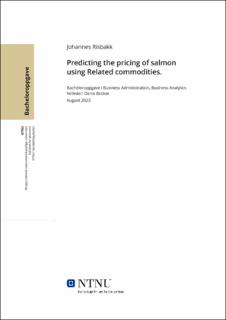| dc.contributor.advisor | Becker, Denis | |
| dc.contributor.author | Risbakk, Johannes | |
| dc.date.accessioned | 2023-11-07T18:20:18Z | |
| dc.date.available | 2023-11-07T18:20:18Z | |
| dc.date.issued | 2023 | |
| dc.identifier | no.ntnu:inspera:164182944:166195782 | |
| dc.identifier.uri | https://hdl.handle.net/11250/3101232 | |
| dc.description.abstract | Norge er verdens største lakseprodusent, og laks er en av Norges viktigste eksportvarer. For oppdrettere er det av stor verdi å kunne predikere laksepriser, da dette kan hjelpe oppdretterne med å justere produksjonen på både kort og lang sikt. Gode prediksjoner av lakseprisen vil og stor økonomisk gevinst for alle markedsaktører. I denne artikkelen prøver jeg å forutsi prisen på norsk laks basert på historiske priser, andre relaterte råvarer som fiskemel og reker, og NOK-EUR valutakurs.
Fire forskjellige modeller ble brukt for å predikere lakseprisene. Som en baseline ble en naïve no-change modell opprettet for å teste de andre mer komplekse modellene mot. En ARIMA ble brukt som en univariat baseline for å se om de multivariate modellene kunne forbedre prediksjonene ved å bruke de andre råvareprisene og NOK-EUR valutakursen. De to multivariate modellene var en k-nearest neighbors (KNN) tilnærming og en Long Short-Term Memory (LSTM) dyp læring tilnærming. Den naive modellen presterte bedre enn alle de andre modellene på alle nøyaktighetsmetrikkene bortsett fra treffrate, hvor KNN hadde den høyeste scoren. | |
| dc.description.abstract | Norway is the world’s largest salmon producer and salmon is one of Norway’s most important exports. For salmon farmers and market participants, salmon price prediction is of great value as this can help farmers adjust their production in both the short and long term, and there are large economic rewards for providing good predictions of salmon price. In this article I am trying to predict the price of Norwegian salmon based on historical prices, other related commodities like fishmeal and shrimp, and the NOK-EUR exchange rate.
Four different models were employed to predict the salmon prices. As a baseline a naïve no-change forecast was created to test the other, more complex, models against. An ARIMA was used to serve as a univariate prediction baseline to see if the multivariate models could improve the predictions with the use of the commodity prices and the NOK-EUR exchange rate. The two multivariate models were a k-nearest neighbors (KNN) approach and a Long Short-Term Memory (LSTM) deep learning approach. The naïve no-change model was superior to the other models on all but one accuracy metric, hit rate, where KNN had the highest score. | |
| dc.language | eng | |
| dc.publisher | NTNU | |
| dc.title | PREDICTING THE PRICING OF SALMON USING RELATED COMMODITIES | |
| dc.type | Bachelor thesis | |
